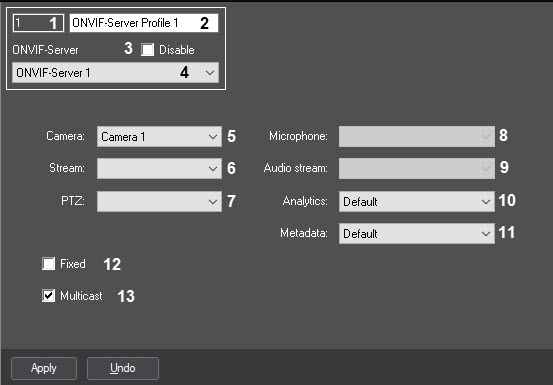
Go to documentation repository
The ONVIF-Server Profile object is used to configure the ONVIF device channel.
The settings panel of the ONVIF-Server Profile object is shown in the figure.
The table describes the setting parameters of the ONVIF-Server Profile object.
| № | Parameter | Method for setting the parameter value | Parameter description | Representation | Default value | Value range |
| 1 | Identification number | Automatically | Displays the identification number of the ONVIF-Server object in the digital video surveillance system with distributed architecture | Numbers, letters, periods, hyphen, dash and underscore | - | Depends on the number of the ONVIF-Server objects in the digital video surveillance system with distributed architecture |
| 2 | Name | Enter the value into the field | Sets the name of the ONVIF-Server object in the digital video surveillance system with distributed architecture | Latin, Cyrillic and service characters | ONVIF-Server | A line containing a sequence of any characters (letters, digits, service characters except > and < characters), case-insensitive. Number of characters—from 1 to 60 |
| 3 | Disable | Set the checkbox | Sets the state (enabled or disabled) of the ONVIF-Server object in the digital video surveillance system with distributed architecture | Boolean type | Clear | Set—the ONVIF-Server object is disabled and isn't used Clear—the ONVIF-Server object is enabled and used |
| 4 | ONVIF-Server | Select the value from the list | Sets the ONVIF-Server parent object in the digital system with distributed architecture to which the given ONVIF-Server Profile object belongs | Names of the ONVIF-Server objects registered in the system | Name of the ONVIF-Server parent object | Depends on the number of the ONVIF-Server objects in the digital video surveillance system with distributed architecture |
| 5 | Camera | Automatically | Sets the Camera object corresponding to the ONVIF-Server Profile object | Names of the Camera objects registered in the system | - | Depends on the number of the Camera objects in the digital video surveillance system with distributed architecture |
| 6 | Stream | Automatically | Sets the video camera stream that is transmitted via the given ONVIF-Server Profile object | List of available video camera streams | - | Depends on the number of the activated video camera streams |
| 7 | PTZ | Automatically | Sets the PTZ object, used for the PTZ control of the camera, corresponding to the ONVIF-Server Profile object | List of PTZ objects corresponding to the selected Camera object | - | Depends on the number of the PTZ objects created and configured in the system |
| 8 | Microphone | Automatically | Sets the Microphone object corresponding to the selected Camera object | List of the Microphone objects corresponding to the selected Camera object | - | Depends on the number of the Microphone objects created and configured in the system |
| 9 | Audio stream | Automatically | Sets the audio stream to be synchronously transmitted with video signal | List of available audio streams | - | Depends on the number of the available audio streams |
| 10 | Analytics | Automatically | Sets the stream to transmit analytics | List of available streams | - | Depends on the number of available streams |
| 11 | Metadata | Automatically | Sets the stream to transmit metadata | List of available streams | - | Depends on the number of available streams |
| 12 | Fixed | Set the checkbox | Disables deleting the ONVIF-Server Profile object using the driver | Boolean type | Clear | Set—the ONVIF-Server Profile object cannot be deleted using the driver Clear—the ONVIF-Server Profile object can be deleted using the driver |
| 13 | Multicast | Set the checkbox | Enables video transmission via the ONVIF-Server in the multicast mode | Boolean type | Clear | Set—video can be transmitted in the multicast mode. Note. There are some extra actions needed besides setting the checkbox in order to enable video transmission in the multicast mode—see Configuring getting video using ONVIF-Server module. Clear—video cannot be transmitted in the multicast mode. |
